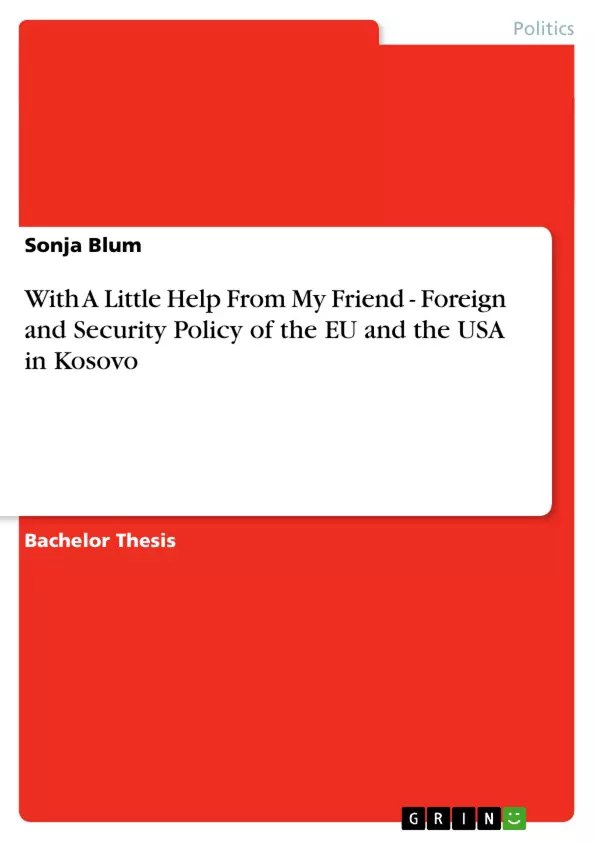"The Western Balkans, and in particular Kosovo, constitute an interesting area of study in the field political science and international relations in that, it not only brings into focus the development and evolution of the European Union (EU) since its inception, but also offers to define the transatlantic relationship between the European Union and the United States of America (USA). The Kosovo Conflict and the surrounding events throughout the Balkans have repeatedly demonstrated that the European Union still lacks the political, judicial and military competencies in its collective approaches to security and foreign policy. Since its inception, the EU had been, and continues to be greatly dependent on its partner and ally, the United States. Hence, the EU was characterized with the Capability-Expectations Gap (CEP), stating that the international environment and the EU itself expect higher outcomes than it is actually capable of delivering. Consequently, the incidents within mainland Europe were accompanied by continuous efforts to improve their Common Foreign and Security Policy (CFSP). During the course of this paper I would like bring into view an objective assessment, in the application of the European Union’s collective approach to regional and international security, and the outreach of its common foreign policy objectives. (...)
I would (also) like to find out whether the presence and involvement of the EU and the US in Kosovo, is simply a method to impose stability and increase security in the region, whether a larger picture is emerging regarding the geopolitical positioning of both entities in Kosovo, or if their interventions are based on a well-functioning and genuine transatlantic cooperation which results in a successful outcome. Furthermore, the questions arise as to whether or not the EU will manage to close the Capability-Expectations Gap through its interventions in Kosovo and if it will finally establish itself as a coordinated institution that is capable of acting independently. And, if this would be the case, what notable developments would occur in EU-US relations? Would the perceptions of the developing world change significantly towards a friendlier and cooperative EU, and would the US’s view on the future interoperability with the EU come under more scrutiny? (...)"
Inhaltsverzeichnis (Table of Contents)
- Introduction
- Capability-Expectations Gap: The Hill-Ginsberg Approach
- History of the Kosovo Conflict
- Foreign and Security Policy of the EU in Kosovo
- EU's Interest in Kosovo
- EU's Interventions in Kosovo
- Evaluation of EU Actions
- Needing the Help of a Friend – The US engages in Kosovo
- Transatlantic Relationship
- The EU's Assessment of the Transatlantic Relations
- The US' Assessment of the Transatlantic Relations
- Iraq War as Crisis and Catalyst
- US Interest for Intervention in Kosovo
- Interventions of the Transatlantic Community
- Evaluation of the Transatlantic Interventions
- Transatlantic Relationship
- Conclusion
Zielsetzung und Themenschwerpunkte (Objectives and Key Themes)
This paper aims to examine the foreign and security policy of the EU and the USA in Kosovo, focusing on the role of both actors in the region and their relationship with each other. The paper specifically investigates the following key themes:- The Capability-Expectations Gap (CEG) of the EU and its implications for its foreign and security policy in Kosovo.
- The role of the EU and the USA in the Kosovo conflict and their interventions in the region.
- The dynamics of the transatlantic relationship, specifically in the context of the Kosovo conflict and the Iraq War.
- The assessment of the EU's and USA's actions in Kosovo, including their effectiveness and impact on the region.
- The potential for the EU to close the CEG through its interventions in Kosovo and establish itself as an independent actor on the world stage.
Zusammenfassung der Kapitel (Chapter Summaries)
The introductory chapter provides an overview of the study's focus on the EU and USA's foreign and security policies in Kosovo, highlighting the CEG and its implications for the EU's role in the region. The chapter then explores the historical context of the Kosovo conflict and its impact on the transatlantic relationship.
Chapter 2 examines the CEG, a concept developed by Hill and Ginsberg, which argues that the EU often faces unrealistic expectations in terms of its ability to achieve its foreign and security policy objectives. This chapter analyzes how the CEG has impacted the EU's actions in Kosovo and the wider international arena.
Chapter 3 provides a historical background of the Kosovo conflict, covering the events leading up to the conflict and the various actors involved. This chapter sets the stage for understanding the EU and the USA's interventions in Kosovo.
Chapter 4 delves into the EU's foreign and security policy in Kosovo. It examines the EU's interests in the region, its interventions in Kosovo, and the evaluation of its actions. This chapter assesses the EU's strengths and weaknesses in addressing the challenges in Kosovo.
Chapter 5 explores the US's involvement in Kosovo, specifically focusing on the transatlantic relationship and its impact on the US's actions in the region. This chapter examines the US's interests in Kosovo and its assessment of the transatlantic relationship, including the impact of the Iraq War. It also analyzes the US's interventions in Kosovo and the evaluation of its actions.
Schlüsselwörter (Keywords)
This paper explores key themes such as the Capability-Expectations Gap, the EU's Common Foreign and Security Policy, the transatlantic relationship, interventions in Kosovo, the Kosovo Liberation Army, the Kosovo Force, the United Nations Interim Administration Mission in Kosovo, and the European Security Strategy. These concepts are central to understanding the EU and the USA's involvement in Kosovo and their broader foreign and security policy agendas.- Quote paper
- Sonja Blum (Author), 2008, With A Little Help From My Friend - Foreign and Security Policy of the EU and the USA in Kosovo, Munich, GRIN Verlag, https://www.grin.com/document/131507



